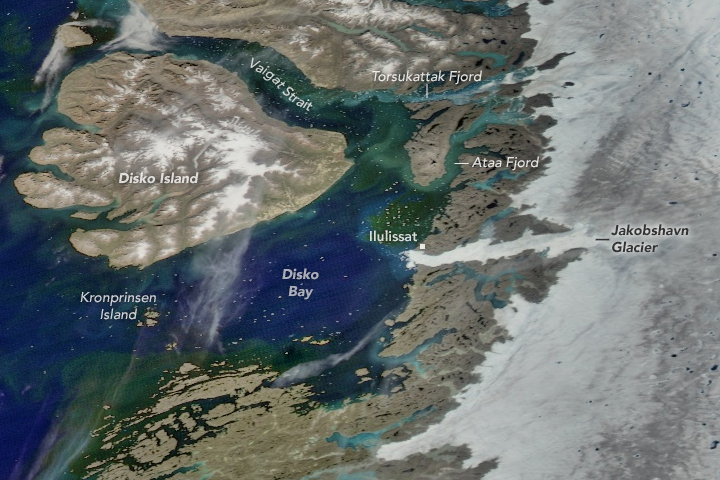

It’s rare to have cloud-free conditions and a clear view of Greenland and its massive ice sheet. But that was the case on July 26, 2016, when the Moderate Resolution Imaging Spectroradiometer (MODIS) on NASA’s Aqua satellite captured these images of the island, its ice, and surrounding waters.
For Jon Hawkings, a scientist at University of Bristol who studies the impact of melting ice sheets on marine ecosystems, the attention-grabbing feature is not the ice. It’s the water. “The most striking thing about these images are the green stains you can see in the coastal regions,” he said.
These “stains” are actually blooms of phytoplankton—microscopic, plant-like organisms that have grown very quickly and in large numbers. The green color comes from the chlorophyll contained in their cells, much like plants on land. Phytoplankton are present near the ocean surface in small numbers all of the time, but they form dense blooms when the conditions are right—such as when there is a stratified layer of surface water and plenty of sunlight and nutrients.
Fresh meltwater that flows off Greenland is buoyant compared to denser, saltier sea water at high latitudes. As a result, an unmixed, “stratified” layer of freshwater forms at the ocean surface where phytoplankton can thrive in the ample sunlight. The nutrients fueling this bloom could have come from previous mixing of the water layers, which transfers nutrients from the deep to the surface. Nutrients can also arrive via glacial meltwater and icebergs that break off the ice sheet.
“The subject of ice sheets being a source of nutrients for phytoplankton is fairly new,” Hawkings said. “There’s still a lot of debate going on as to how great the impact of glacial meltwater is.”
Blooms of phytoplankton are common around Greenland’s coast and fjords in the summer, and they play a key role in the ecosystem. “They’re fantastic and important little creatures, as they suck up carbon dioxide and form the base of the oceanic food chain,” Hawkings said.
Their role is especially important in Disko Bay, the largest bay in the region. According to Erik Mousing, a scientist at the University of Copenhagen, the bay has been important to the local economy for at least 1,000 years because of its abundant marine resources including shrimps, seals, whales, and walruses. All of these animals ultimately depend on phytoplankton, which form the base of the marine food web.

The detailed view of the bay in the second image shows that the green color is not uniformly distributed. These patterns are not random. They are the result of water masses from different sources meeting in the bay.
Most of the water entering the bay from the west comes from the West Greenland Current. This relatively salty, warm water from the North Atlantic moves north along Greenland’s coast, then enters the bay around the north and south sides of Kronprinsen Island. The water fills up at the surface of the bay’s center and appears blue which signifies that it likely contains only a small amount of phytoplankton.
In contrast, the eastern side of the bay has more cold, fresh meltwater from Greenland’s glaciers. The most important of these glaciers is Jakobshavn, which is the largest and fastest ice stream in the northern hemisphere. On average, 70 million tons of icebergs are calved into the Ilulissat Icefjord from this glacier every day.
Icebergs leaving the fjord usually move north and exit the bay south of Disko Island or through the Vaigat Strait. According to Mousing, the nutrients delivered by these icebergs and by glacial melt lead to the high concentration of phytoplankton north of Ilulissat. This same phenomenon explains the patches of color near the Torsukattak and Ataa Sund fjords, where the movement of meltwater can be traced as green filaments. The filaments also contain a milky turquoise color, which is probably caused by discharge of suspended minerals, or “glacial flour.”
The two main water masses stay relatively unmixed due to a frontal system that forms where they meet. “The front prevents much water being exchanged between the central bay and the meltwater-rich eastern regions,” Mousing said. “As a result, phytoplankton in these two areas have different levels of productivity and are likely composed of different species.”
NASA images by Norman Kuring, NASA’s Ocean Color web. Caption by Kathryn Hansen.